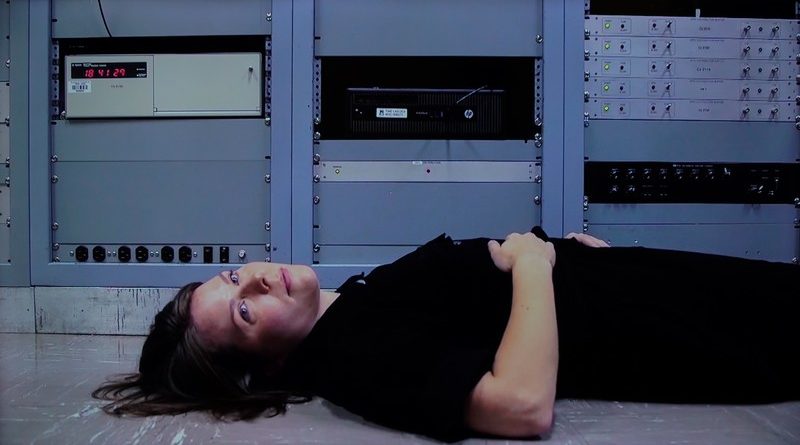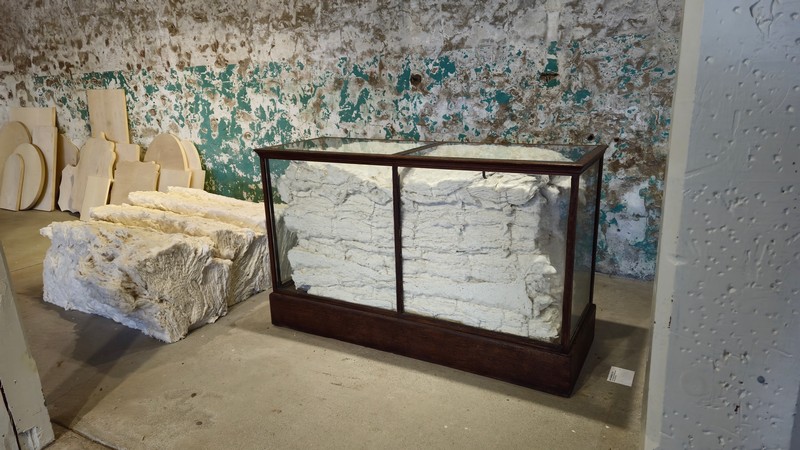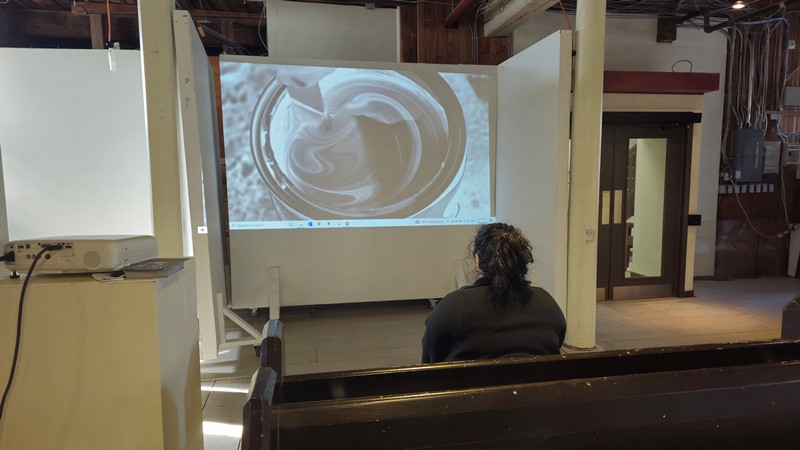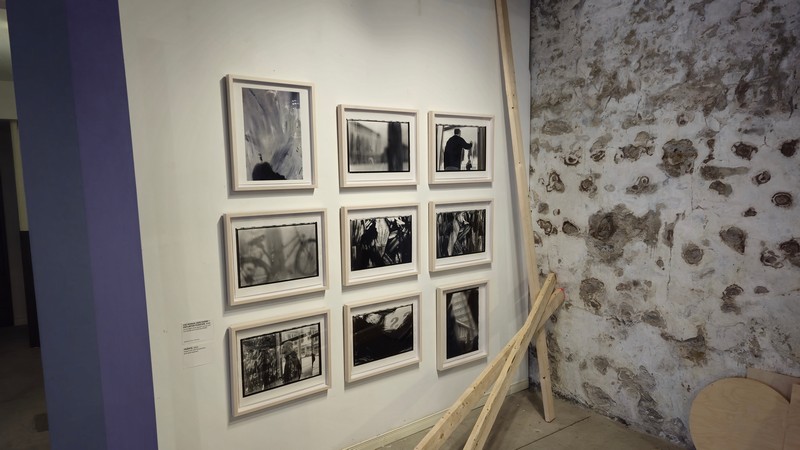Questions of time and place: two art exhibitions
Maureen Korp
Are we drones-in-the-making? Or, has that already happened? Two solo art exhibitions provoke hard questions about the ways we count our days, know ourselves as technologically enhanced beings. “Factory,” the work of Robert Tombs, an Ottawa artist, is at the Mississippi Valley Textile Museum in nearby Almonte. “Tenuous Systems,” the work of Toronto artist Emily DiCarlo, is found in Ottawa’s Karsh-Masson Gallery at City Hall. Almonte is but 30 minutes away. Let’s look there first.
The historic industrial setting of the Mississippi Valley Textile Museum in Almonte underscores the importance of Robert Tombs’ work in “Factory.” The exhibition is housed in an old factory that once made uniforms for the British military. Its waterwheel remains operative; bird calls are heard through the windows. Walk into the exhibition. Rows of columns pull the visitor’s eye to “Made-to-Measure,” 2023, a work centred on the back wall. It is composed of rows of wooden sticks, each one the same size, 100 in all. What are they? Stir sticks. Paint is stirred before it can be used. Not one stick is really the same as another. On the floor sits a four-litre can of paint. Robert Tombs’ work is site-specific here, now, then and there.
“On Canvas,” 2024, a large oak display case stuffed with cotton, bales of cotton, pulls our thoughts further. Cotton grown in plantation rows, cotton picked by workers, then and now, having little choice in the matter. Who are they? Look to “Signature,” 2024. The artist covered one of the factory’s pillars with black handprints. No more is said of the matter.
In 2008, in eastern Germany, the former GDR, Robert Tombs installed a site-specific exhibition entitled “Die Moral der Farbe: Erfurter Fenster” (“The Morality of Colour: Erfurt Windows) at the University of Erfurt. The work was located in a building on campus called the “glassbox.” Its windows open onto views of the university, the town of Erfurt, and, not far off, Buchenwald’s towers where as many as 55,000 people, possibly more, were killed, 1937-45.
Throughout the month of his work at the glassbox, Tombs painted its windows. In Almonte, we see this work in two formats—photography and video.
Robert Tombs’ black-and-white photographs of the glassbox windows are complex views. The nine photographs look inward and outward. They document the artist painting the windows inside as people walk by outside. Some look in, others do not. A world outside, yet inside.
The video of the Erfurt glassbox installation is one of three short videos being screened on a continuous loop in “Factory.” “Die Moral der Farbe: Erfurter Fenster” (“The Morality of Colour: Erfurt Windows), six minutes long, celebrates the artist’s Erfurt work. Have a seat. Sunlight beams through black swashes of paint, people applaud the artist as he walks into the room, most of them anyway. Outside, a police siren can be heard.
In “Autobiography,” 2023, a 10-minute video, we do not see the artist nor his hand. We are looking at a graceful, hypnagogic swirl of dark and white, circling, flowering, returning, greying into nothingness. The end. Awaken. Does it matter? Yes.
“Birgus Mark, 12 July 2007” is a two-minute video. We see the artist’s hand splashing paint onto a rock in Newfoundland. Not just any rock. Through the camera’s viewfinder we can see the ocean beyond, as well as rocks nearby. The paint prompts a second look. The shifting points-of-view of trance states sometimes enable experiences scholars call “kratophany,” the phenomena many cultures have termed “sacred,” and specific to time and place. From the beginnings of time, people have marked such places, an acknowledgement of those understandings.
Does A.I. know that, too? Is it time to punch-in?
Currently, the Karsh-Masson Gallery at City Hall is the site of “Tenuous Systems,” a troublesome installation by Emily DiCarlo. “Global Grind,” 2023, a punch clock with time cards, awaits your arrival. It hangs in the gallery’s entryway. You may punch in.
The artist has studied the environs of Ottawa’s National Research Council, the NRC, its activities, and the histories of its machinery. In “Tenuous Systems” we see the outcome of DiCarlo’s studies of her subject matter. What are the structures of time today? The UTC, coordinated universal time? Do human beings matter today? One wonders.
The three screens, for example, of “The Propagation of Uncertainty,” 2020 present a 5:40-minute projection of a woman lying on the floor in a laboratory. The figure comes into view, feet first, her head turned towards us, eyes open. The computer behind her is labelled: FLUKE—PM680B–high resolution programmable-timer-counter.” The screens go dark, then it all starts over.
Four of the seven artworks in the exhibition include video components, short and long, 4 to 51 minutes in length. There is no seating in the gallery for visitors, nowhere to sit, listen, and understand. At only two stations are earphones provided. The sound components heard are scatterings of misbegotten words. So, too, the installation identifications—for example, “Circular T: A Collection of Uncertainties,” 2020.
Then again, that may well be the exhibition’s raison d’être. “Tenuous Systems” would have no certainty. Some days are like that.
Continuing exhibitions
Robert Tombs—Factory, until April 13
Mississippi Valley Textile Museum, Almonte. Wheelchair accessible. Tues.-Sat., 1-4 p.m.
Emily DiCarlo—Tenuous Systems Systèmes Fragiles, until April 14
Karsh-Masson Art Gallery, City Hall. Wheelchair accessible. Open daily, 9 – 5 p.m.
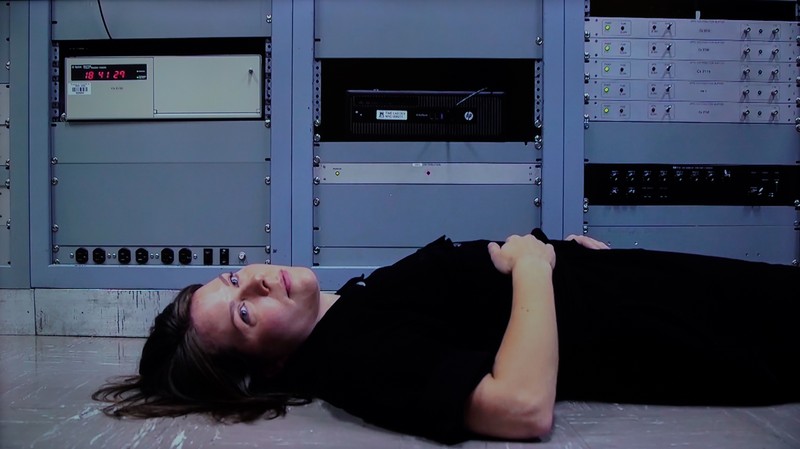
Photo: David Barbour
